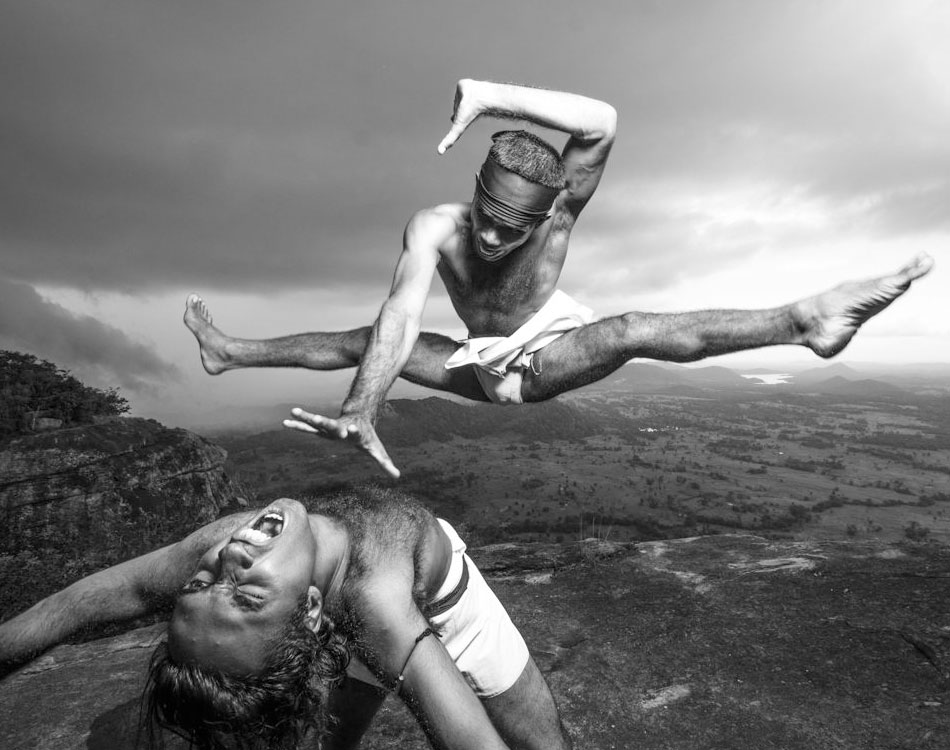ANGAMPORA SHOW
Angampora is a form of martial art from Sri Lanka that combines combat techniques, self-defence, sport, exercise and meditation.
It's been more than a million years since the first human was born and since then they've had to face a gazillion challenges in this rapidly changing world. In the past ages, where the law of “survival of the fittest” prevailed, this tiny nation had to hold its own, mostly against the mighty India (South India” Chola Kingdom). The kings of India many a time thought to have this “Pearl of the Indian Ocean” to decorate their crowns and invaded the island. But invariably, each time, they were driven back. Such was the invincible might of the fighting techniques practiced by the people of Sri Lanka and they called it the ANGAM SATAN KALAWA (fighting art named ANGAM).
The exact date of the origin of Angampora is unknown. The origins of Angampora are scattered throughout history. It's believed to be older than 33,000 years along with the story of Kataragama Mahasen, the brave Angampora warrior of Yakkha tribe. Later at the time of Maha Ravana who was born to the same tribe, Angampora was vastly expanded. It became more popular as it was introduced to Buddhist civilization.
Throughout the time of King Dutugemunu, the ten giant warriors of his army (Dasa Maha Yodhayo) used Angampora techniques in the battles against the Warlord Elara. Gotaimbara was one of the ten giants, and he had a separate conflict with Ritigala Jayasena, a powerful member of Yakkha tribe. Gotaimbara tried to flirt with Jayasena's beautiful wife which led to a huge fight. According to Mahãvamsa, Gotaimbara had decaptiated Jayasena by a single Angampora kick to the neck.
In the days of ancient Sinhala Kingdoms, it was the fighting technique of the noblemen. Angampora continued with the Sinhala kings with the changeover of the kingdoms towards the southwest of the country. However, with each new king, new gurus were appointed and as a result the pedigree of the gurus of Angampora got weakened.
For thousands of years Angampora fighters sacrificed their lives not only to protect the state from foreign assaults, but also to protect this form of martial art. Angampora was well respected and considered divine by its practitioners.
There are hundreds of martial arts in the known world and Angampora, the traditional martial art devised by ancient Sri Lankans is known to possess some of the most lethal, highly disciplined techniques in the world.
The term Angampora refers to physical combat, and is essentially the martial use of limbs, but no weapons. It's categorized into three types; Pora Haramba (offensive and defensive techniques), Gataputtu (grips and locks) and Maru Kala (Vital point attacks).
A key component of Angampora is the namesake angam, which incorporates hand-to-hand fighting, and illangam, involving the use of indigenous weapons such as the ethunu kaduwa, staves, knives and swords. Another component known as maya angam, which uses spells and incantations for combat, is also said to have existed. Angampora's distinct feature lies in the use of pressure point attacks to inflict pain or permanently paralyze the opponent. Fighters usually make use of both striking and grappling techniques, and fight until the opponent is caught in a submission lock that they cannot escape.
A variety of weapons are used in Angampora. However, only the most experienced fighters use these weapons, as there is a risk of cutting oneself badly while lashing out at an adversary. There is the combat sword. This thick instrument is custom made for the fighter. The length of the sword is similar to the distance between the fighter’s fingertips and his under arm. A smaller variety of sword, known as the ‘Keti Kaduwa’, is also used. This is used together with a small shield or ‘Paliya’, which is about the size of a normal wall clock.
Later Angampora went through a fall, almost disappearing during the colonial era. The main reason for this was that Angampora was highly dreaded by the British during their invasion. They took dreadful actions to prevent the practice of Angampora, such as burning practice huts, shooting the kneecaps of the existing practitioners to maim and scare them.
Angampora isn't just an ancient martial art that originated in Sri Lanka, but a symbol that portrays our cultural value as a country and serves as a reminder of our fearless nation!
Day Tours
See more
See less
Round Tours
See more
See less
Things To Do
See more
See less

